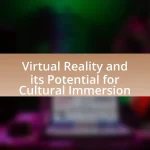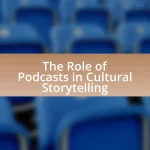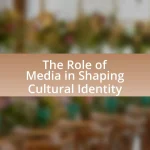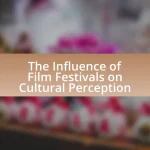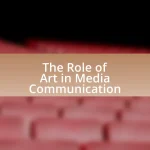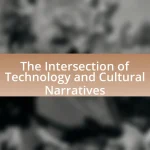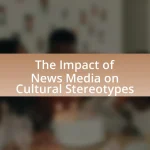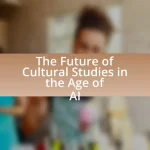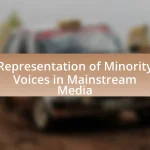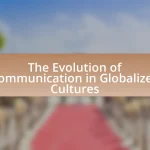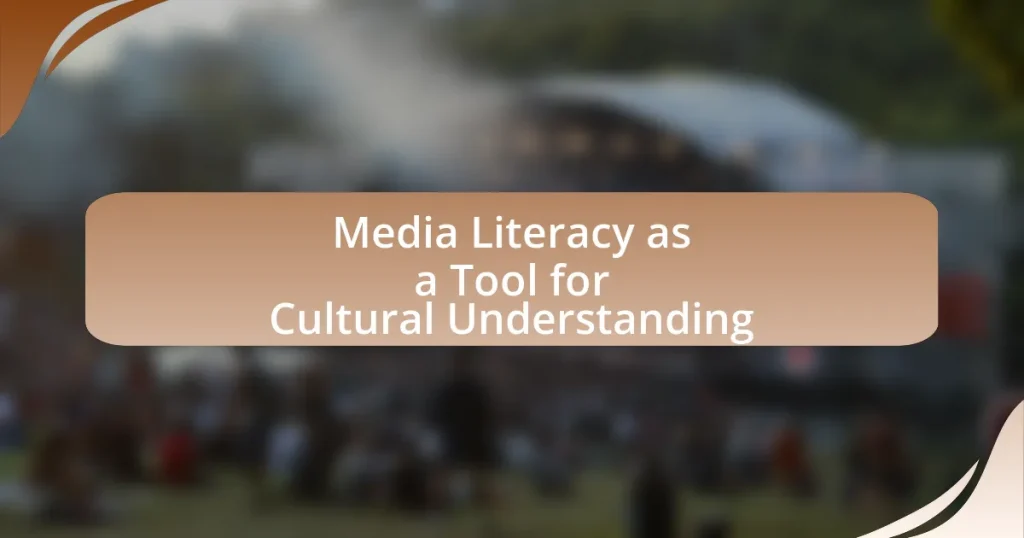Media literacy is defined as the ability to access, analyze, evaluate, and create media, which is essential for understanding and engaging with diverse cultural perspectives. This article explores the role of media literacy in enhancing cultural awareness, reducing stereotypes, and fostering empathy. It discusses key components of media literacy, its impact on perceptions of different cultures, and the importance of integrating media literacy education into curricula and community programs. Additionally, it addresses the challenges faced without media literacy, the influence of misinformation, and practical steps individuals can take to improve their media literacy skills.
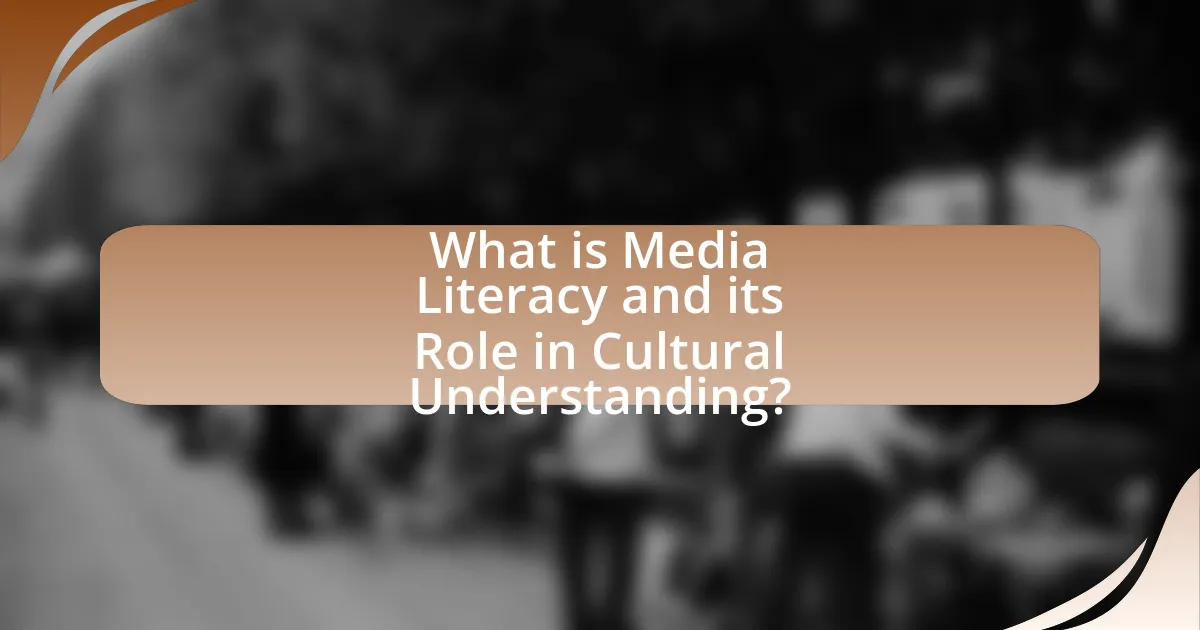
What is Media Literacy and its Role in Cultural Understanding?
Media literacy is the ability to access, analyze, evaluate, and create media in various forms, enabling individuals to understand and critically engage with media content. This skill plays a crucial role in cultural understanding by fostering awareness of diverse perspectives and narratives, which helps individuals navigate and interpret the complexities of different cultures. Research indicates that media literacy education enhances critical thinking and empathy, allowing individuals to appreciate cultural differences and reduce stereotypes. For instance, a study by the National Association for Media Literacy Education highlights that media literacy programs can significantly improve students’ understanding of cultural contexts and promote inclusivity.
How does Media Literacy contribute to cultural awareness?
Media literacy enhances cultural awareness by equipping individuals with the skills to critically analyze and interpret media messages from diverse cultural perspectives. This critical analysis fosters an understanding of different cultural narratives, values, and practices, allowing individuals to recognize biases and stereotypes in media representations. Research indicates that media literacy programs can significantly improve students’ ability to engage with multicultural content, promoting empathy and reducing prejudice. For instance, a study published in the Journal of Media Literacy Education found that participants in media literacy initiatives demonstrated increased awareness of cultural diversity and improved intercultural communication skills.
What are the key components of Media Literacy?
The key components of media literacy include the ability to access, analyze, evaluate, and create media in various forms. Accessing media involves identifying and utilizing different media platforms effectively. Analyzing media requires critical thinking to understand the messages and purposes behind media content. Evaluating media involves assessing the credibility and reliability of sources, while creating media encompasses the skills needed to produce content that communicates effectively. These components are essential for individuals to navigate the complex media landscape and engage with diverse cultural perspectives.
How does Media Literacy influence perceptions of different cultures?
Media literacy significantly influences perceptions of different cultures by equipping individuals with critical thinking skills to analyze and interpret media messages. This analytical ability allows people to discern biases, stereotypes, and misrepresentations in media portrayals of cultures, leading to a more nuanced understanding. Research indicates that individuals with higher media literacy are less likely to accept stereotypes and more likely to appreciate cultural diversity, as evidenced by studies showing that media literacy education can reduce prejudice and foster empathy towards different cultural groups.
Why is Media Literacy essential in a globalized world?
Media literacy is essential in a globalized world because it empowers individuals to critically analyze and evaluate the vast array of information they encounter across diverse media platforms. In a context where misinformation and biased narratives can easily spread, media literacy equips people with the skills to discern credible sources from unreliable ones, fostering informed decision-making. According to a study by the National Association for Media Literacy Education, individuals with strong media literacy skills are better able to navigate complex media landscapes, which is crucial for understanding different cultures and perspectives in an interconnected society. This ability to critically engage with media not only enhances personal understanding but also promotes cross-cultural dialogue and empathy, essential components for coexistence in a globalized environment.
What challenges do individuals face without Media Literacy?
Individuals without media literacy face significant challenges in critically evaluating information, leading to misinformation and manipulation. This lack of skill results in difficulty distinguishing credible sources from unreliable ones, which can perpetuate false narratives and stereotypes. According to a study by the Stanford History Education Group, 82% of middle school students could not distinguish between a sponsored post and a news article, highlighting the pervasive issue of misinformation. Furthermore, individuals may struggle to engage in informed discussions about cultural issues, limiting their understanding and appreciation of diverse perspectives. This gap in media literacy can hinder social cohesion and exacerbate cultural misunderstandings, as individuals are less equipped to navigate the complexities of media messages in a globalized world.
How does Media Literacy promote critical thinking about cultural narratives?
Media literacy promotes critical thinking about cultural narratives by equipping individuals with the skills to analyze and evaluate media messages. This analytical capability allows people to discern biases, recognize stereotypes, and understand the context in which cultural narratives are presented. Research indicates that media literacy education enhances critical thinking skills, enabling individuals to question the motives behind media content and its impact on societal perceptions. For instance, a study by the National Association for Media Literacy Education found that students who received media literacy training demonstrated improved critical thinking skills and a greater ability to identify misinformation in media narratives.
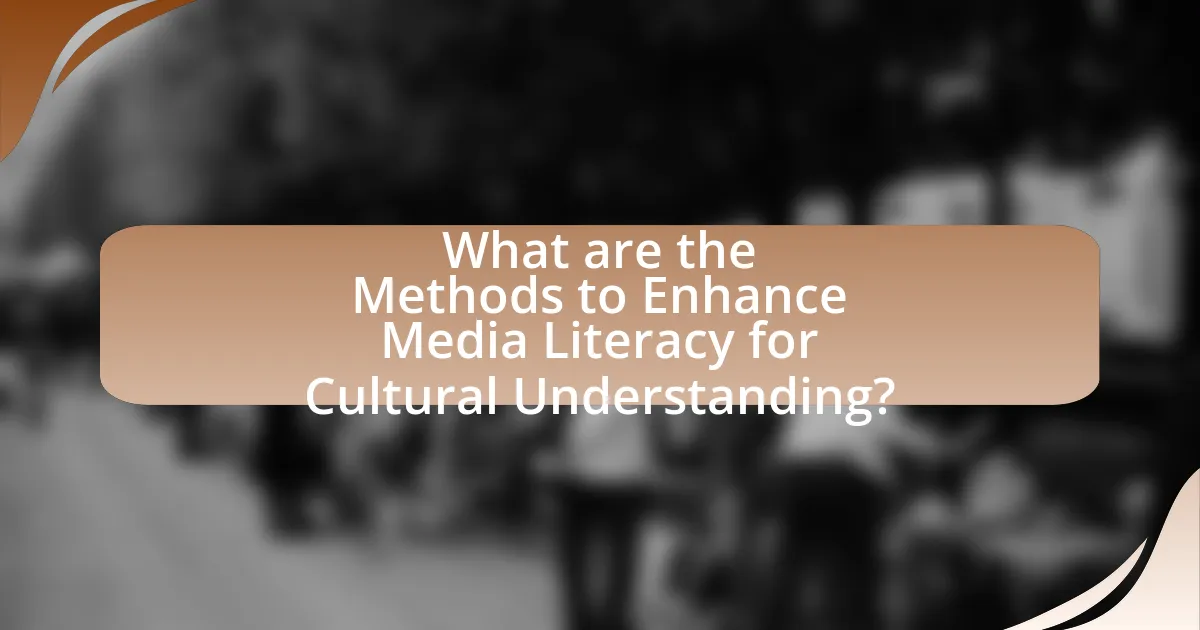
What are the Methods to Enhance Media Literacy for Cultural Understanding?
Methods to enhance media literacy for cultural understanding include integrating critical thinking skills into educational curricula, promoting diverse media representation, and utilizing community-based workshops. Educational institutions can implement programs that teach students to analyze and evaluate media content critically, fostering an understanding of different cultural perspectives. Research indicates that exposure to diverse media can reduce stereotypes and promote empathy, as seen in studies like “The Impact of Media Literacy on Cultural Understanding” by the Media Literacy Research Group, which highlights the positive correlation between media literacy education and cultural awareness. Additionally, community workshops that engage participants in discussions about media portrayals of various cultures can further enhance understanding and appreciation of cultural diversity.
How can educational institutions integrate Media Literacy into their curricula?
Educational institutions can integrate Media Literacy into their curricula by incorporating it as a core component across various subjects. This integration can be achieved through the development of specific courses focused on analyzing media messages, understanding media production, and evaluating the impact of media on society. Research indicates that programs like the “Media Literacy Now” initiative have successfully implemented media literacy standards in educational frameworks, demonstrating improved critical thinking skills among students. By training educators to deliver media literacy content and providing resources that align with national educational standards, institutions can foster a more informed and culturally aware student body.
What teaching strategies are effective for fostering Media Literacy?
Effective teaching strategies for fostering media literacy include critical analysis of media content, project-based learning, and collaborative discussions. Critical analysis encourages students to evaluate the credibility, bias, and purpose of various media sources, enhancing their ability to discern information quality. Project-based learning allows students to create their own media products, which helps them understand the production process and the implications of media messages. Collaborative discussions promote peer-to-peer learning, where students can share perspectives and challenge each other’s viewpoints, fostering a deeper understanding of media’s role in society. Research by the Center for Media Literacy indicates that these strategies significantly improve students’ media literacy skills, enabling them to navigate the complex media landscape effectively.
How can technology be leveraged to improve Media Literacy skills?
Technology can be leveraged to improve Media Literacy skills by providing interactive platforms and resources that enhance critical thinking and analysis of media content. For instance, online courses and educational apps can offer structured learning experiences that teach users how to evaluate sources, discern bias, and understand media production processes. Research indicates that digital tools, such as fact-checking websites and media analysis software, empower individuals to verify information and develop a more nuanced understanding of media messages. A study by the Stanford History Education Group found that students who used digital literacy tools demonstrated improved abilities to assess the credibility of online information.
What role do community programs play in promoting Media Literacy?
Community programs play a crucial role in promoting media literacy by providing accessible education and resources that empower individuals to critically analyze media content. These programs often include workshops, seminars, and collaborative projects that engage participants in discussions about media influence, misinformation, and digital citizenship. For instance, a study by the Media Literacy Now organization highlights that community-based initiatives can significantly enhance participants’ ability to discern credible information from false narratives, thereby fostering informed decision-making. By creating a supportive environment for learning and dialogue, community programs effectively bridge gaps in media understanding across diverse populations.
How can workshops and seminars enhance understanding of cultural media?
Workshops and seminars enhance understanding of cultural media by providing interactive platforms for participants to engage with diverse media forms and cultural contexts. These educational settings facilitate critical discussions, allowing attendees to analyze and reflect on the impact of media representations on cultural perceptions. Research indicates that experiential learning, such as that found in workshops, significantly improves retention and comprehension of complex topics, including cultural narratives. For instance, a study by the National Association for Media Literacy Education highlights that hands-on activities in workshops lead to a deeper understanding of media’s role in shaping cultural identities.
What partnerships can be formed to support Media Literacy initiatives?
Partnerships that can be formed to support Media Literacy initiatives include collaborations between educational institutions, non-profit organizations, government agencies, and media companies. Educational institutions can develop curricula that incorporate media literacy, while non-profit organizations can provide resources and training for educators and community members. Government agencies can offer funding and policy support to enhance media literacy programs, and media companies can contribute by creating content that promotes critical thinking and responsible media consumption. For instance, the Media Literacy Now organization advocates for state-level policies to integrate media literacy into education, demonstrating the effectiveness of such partnerships in fostering informed media consumption.

What are the Impacts of Media Literacy on Cultural Perceptions?
Media literacy significantly impacts cultural perceptions by enhancing individuals’ ability to critically analyze and interpret media messages. This critical analysis fosters a deeper understanding of diverse cultural narratives, reducing stereotypes and promoting empathy. Research indicates that individuals with higher media literacy skills are more likely to engage with and appreciate cultural differences, as evidenced by a study published in the Journal of Media Literacy Education, which found that media literacy education programs led to increased cultural awareness among participants. Thus, media literacy serves as a vital tool in shaping positive cultural perceptions and fostering inclusivity.
How does Media Literacy affect stereotypes and biases?
Media literacy significantly reduces stereotypes and biases by equipping individuals with critical thinking skills to analyze and evaluate media messages. When people are media literate, they can discern the underlying messages and representations in media content, which often perpetuate stereotypes. Research indicates that media literacy programs can lead to a decrease in prejudiced attitudes; for example, a study published in the Journal of Media Literacy Education found that participants who engaged in media literacy training showed a marked reduction in stereotypical thinking about marginalized groups. This demonstrates that enhancing media literacy fosters a more nuanced understanding of diverse cultures, ultimately challenging and changing harmful biases.
What evidence exists linking Media Literacy to reduced cultural misunderstandings?
Media literacy has been shown to reduce cultural misunderstandings by enhancing individuals’ critical thinking skills and promoting empathy towards diverse perspectives. Research conducted by the National Association for Media Literacy Education indicates that media literacy education fosters an understanding of cultural contexts, which helps individuals interpret media messages more accurately. Additionally, a study published in the Journal of Media Literacy Education found that participants who engaged in media literacy programs demonstrated improved intercultural communication skills and a greater appreciation for cultural diversity. These findings suggest that media literacy equips individuals with the tools necessary to navigate and understand cultural differences, thereby minimizing misunderstandings.
How can Media Literacy reshape narratives about marginalized cultures?
Media literacy can reshape narratives about marginalized cultures by equipping individuals with critical thinking skills to analyze and evaluate media representations. This empowerment allows audiences to recognize biases, stereotypes, and misrepresentations in media portrayals, fostering a more nuanced understanding of these cultures. For instance, studies have shown that media literacy programs can lead to increased awareness of cultural diversity and reduced prejudice, as participants learn to question dominant narratives and seek out authentic voices from marginalized communities. By promoting diverse perspectives and encouraging critical engagement with media, media literacy serves as a vital tool in transforming societal narratives and enhancing cultural understanding.
What are the potential drawbacks of Media Literacy initiatives?
Media Literacy initiatives can lead to several potential drawbacks, including the risk of oversimplification of complex media messages. When individuals are taught to critically analyze media, they may inadvertently reduce nuanced content to binary interpretations, which can distort understanding. Additionally, these initiatives may create a false sense of security, where individuals believe they are fully equipped to navigate media landscapes, potentially leading to complacency in critical thinking. Research indicates that while media literacy can enhance critical thinking skills, it does not guarantee that individuals will apply these skills effectively in real-world situations, as evidenced by studies showing that even educated individuals can fall prey to misinformation.
How can misinformation undermine Media Literacy efforts?
Misinformation can significantly undermine media literacy efforts by creating confusion and distrust among audiences regarding credible sources. When individuals encounter false information, they may struggle to differentiate between reliable and unreliable content, which directly contradicts the goals of media literacy that aim to enhance critical thinking and informed decision-making. Research indicates that exposure to misinformation can lead to a decrease in the ability to evaluate media sources effectively, as demonstrated in studies showing that individuals who frequently consume misinformation are less likely to engage in critical analysis of media content. This erosion of critical skills ultimately hampers the effectiveness of media literacy initiatives designed to foster cultural understanding and informed citizenship.
What are the risks of oversimplifying cultural complexities through Media Literacy?
Oversimplifying cultural complexities through Media Literacy can lead to the perpetuation of stereotypes and a lack of nuanced understanding of diverse cultures. When media literacy programs reduce intricate cultural narratives to simplistic representations, they risk fostering misconceptions that can reinforce biases. For example, studies have shown that media portrayals often emphasize certain traits while ignoring the broader context of cultural practices, leading to a skewed perception of those cultures. This oversimplification can hinder meaningful dialogue and understanding, as individuals may rely on these narrow representations rather than engaging with the rich, multifaceted realities of different cultural groups.
What practical steps can individuals take to improve their Media Literacy?
Individuals can improve their media literacy by actively engaging in critical analysis of media content. This involves questioning the sources of information, evaluating the credibility of the content, and recognizing biases in reporting. For instance, studies show that individuals who practice critical thinking skills are better equipped to discern misinformation, as highlighted in the research by the Stanford History Education Group, which found that students often struggle to evaluate online sources effectively. Additionally, participating in media literacy programs or workshops can provide structured learning experiences that enhance understanding of media influence and techniques. Engaging with diverse media formats, such as news articles, podcasts, and documentaries, also broadens perspectives and fosters a more nuanced understanding of cultural contexts.
How can one critically evaluate media sources for cultural content?
To critically evaluate media sources for cultural content, one should assess the source’s credibility, analyze the representation of cultural elements, and consider the context in which the content is produced. Credibility can be determined by examining the author’s qualifications, the publication’s reputation, and the presence of citations or references to reliable data. Analyzing representation involves looking at how different cultures are portrayed, identifying stereotypes, and recognizing the diversity within cultural groups. Contextual consideration includes understanding the historical, social, and political factors influencing the media content. For instance, a study by the Pew Research Center highlights that media representation can significantly shape public perceptions of cultural groups, underscoring the importance of critical evaluation in fostering cultural understanding.
What resources are available for enhancing personal Media Literacy skills?
Resources available for enhancing personal media literacy skills include online courses, workshops, and educational websites. For instance, organizations like the Media Literacy Now initiative provide comprehensive resources and advocacy for media literacy education. Additionally, platforms such as Coursera and edX offer courses on media literacy from accredited institutions, allowing individuals to learn at their own pace. Research indicates that media literacy education can significantly improve critical thinking and analytical skills, which are essential for navigating today’s complex media landscape.
